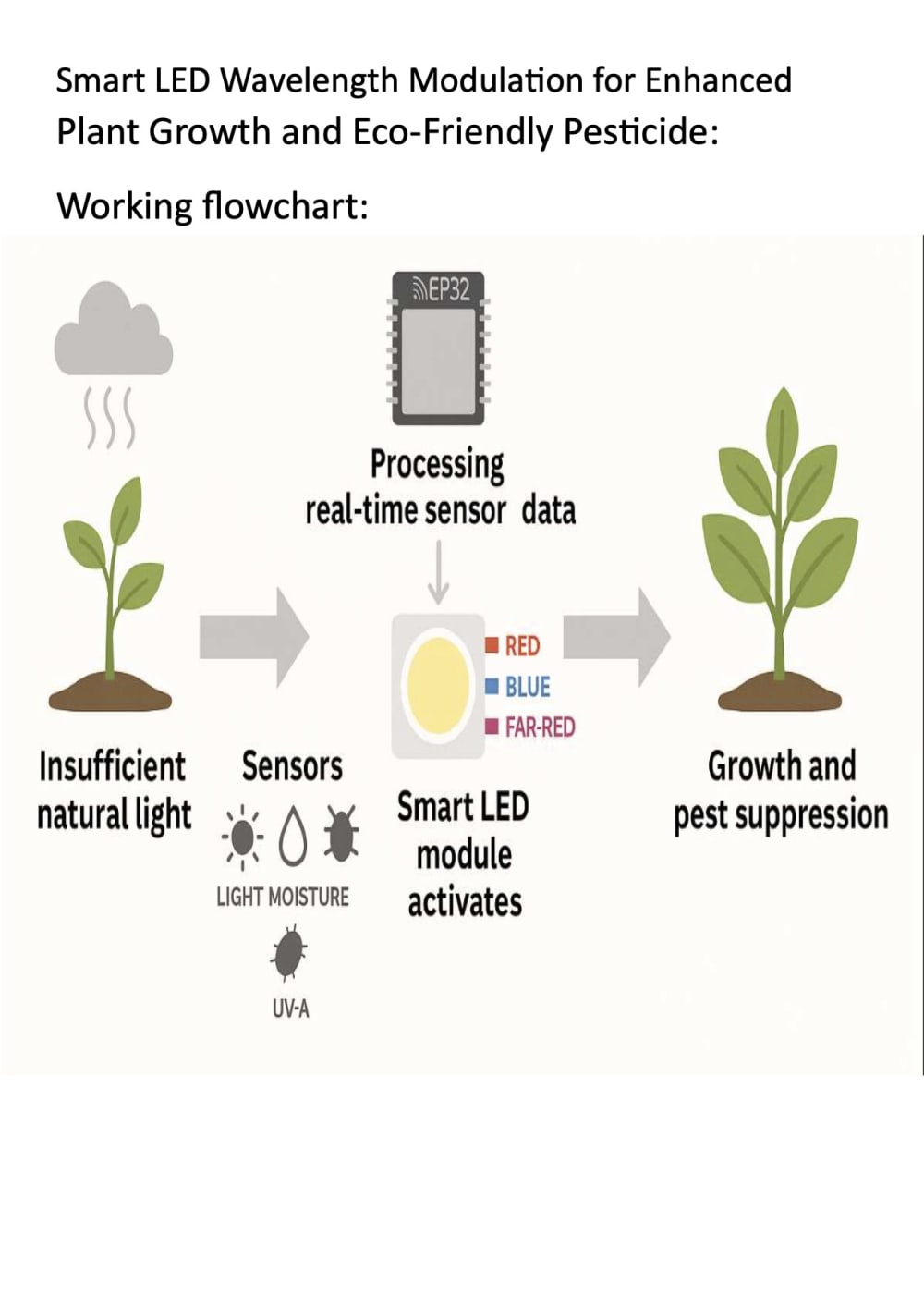This project introduces an intelligent, solar-powered LED modulation system designed to optimize plant growth and offer sustainable, chemical-free pest control. The system operates autonomously, using sunlight as the power source and a programmable controller (ESP32) to adjust LED wavelengths and intensity depending on environmental conditions.
Working Principle
The working principle is based on the modulation of specific light wavelengths (red, blue, and UV-A) that influence plant behavior and deter pests. Red light (660 nm) supports flowering and stem elongation, blue light (450–470 nm) promotes vegetative growth, and UV-A light (365–400 nm) is effective in disrupting the sensory systems of nocturnal pests like moths and mosquitoes.
Power is supplied through a 12W solar photovoltaic (PV) panel, which charges and powers the system through an LM2596 buck converter that steps down and regulates voltage for safe electronic operation.
The ESP32 microcontroller forms the core of the system, receiving inputs from:
- An LDR (Light Dependent Resistor) that monitors ambient light intensity,
- An HC-SR501 PIR sensor that detects pest or motion activity in the surroundings,
- An SP3T mode switch that allows selection of three operational modes: Day, Night, and Day & Night.
Based on sensor inputs and the selected mode, the ESP32 dynamically controls LED outputs through PWM (Pulse Width Modulation) signals. These PWM signals drive BSP31/BSP36 MOSFETs which regulate current to the respective LEDs:
- Red LED – for growth during the day,
- Blue LED – for vegetative response,
- UV-A LED – for night-time pest control.
Detailed Operation
- Day Mode: When sufficient sunlight is detected by the LDR, the red and blue LEDs are activated to support photosynthesis and plant growth.
- Night Mode: When darkness is detected and pests are sensed, UV-A LEDs are activated, providing pest repellent lighting without using chemicals.
- Day & Night Mode: The system intelligently switches between plant growth support (day) and pest control (night) based on real-time sensor data.
This adaptive operation ensures maximum energy efficiency, enabled by PWM control and solar input, and provides an automated agro-tech solution for small to medium-scale farms and home gardens.
Scientific and Engineering Principles
- Semiconductor Physics: ESP32 microcontroller and MOSFETs operate on low-power digital logic and semiconductor switching principles.
- Optoelectronics: LEDs emit photons when electrons recombine across p-n junctions. UV-A LEDs emit high-energy light affecting pests biologically.
- Sustainable Energy Management: Solar energy conversion via photovoltaic effect powers the system using clean, renewable energy.
Sensor Integration and Automation: Analog and digital sensors provide data feedback for autonomous control logic.
Conclusion
This design is cost-effective, scalable, and environmentally friendly. It brings together solar power, LED spectral science, embedded control, and pest deterrence in a compact and automated system. This project has potential applications in organic farming, greenhouse automation, smart agriculture, and remote plantation management, promoting food safety and ecological sustainability.
Like this entry?
-
About the Entrant
- Name:Sri Balaji M
- Type of entry:teamTeam members:
- SRI BALAJI M
- Lakshen V
- Bhadri Prabhu K
- Software used for this entry:Proteus
- Patent status:none


